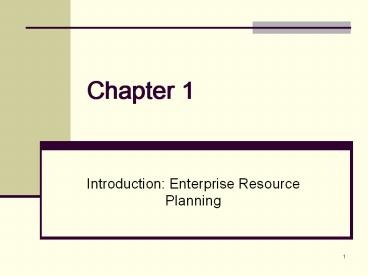Introduction: Enterprise Resource Planning - PowerPoint PPT Presentation
1 / 25
Title:
Introduction: Enterprise Resource Planning
Description:
Chapter 1 Introduction: Enterprise Resource Planning Chapter 1 Learning Objectives Explain what a business is Name a business s main functional areas of operation ... – PowerPoint PPT presentation
Number of Views:453
Avg rating:3.0/5.0
Title: Introduction: Enterprise Resource Planning
1
Chapter 1
- Introduction Enterprise Resource Planning
2
Chapter 1 Learning Objectives
- Explain what a business is
- Name a businesss main functional areas of
operation - Differentiate a business process from a business
function - Identify the kinds of data that each main
functional area produces - Identify the kinds of data that each main
functional area needs - Define integrated information systems and state
why they are important
3
Definition of a Business
- A business is an organization that sells goods or
services to customers (or clients) in exchange
for money or other things of value.
4
Introduction Enterprise Resource Planning
- Manage company-wide business operations
- Uses a common database and shared management
reporting tools
5
Functional areas of operation
- Marketing and Sales
- Production and Materials Management
- Accounting and Finance
- Human Resources
6
Ex Procurement
- Cost
- Quality
- Availability
- Management
7
Business Processes
- Managers now think in terms of business process
- Take the customers perspective
- Customer is always right
- If not reread rule 1
8
Business Process
- A business process is a collection of activities
that takes inputs and creates outputs that are a
value to a customer
9
Business Processes Cut Across Functional Lines
10
Example Buying a new computer
- Information on products available
- Place order quickly, maybe obtain financing
- Quick delivery
- 24 Hour help
11
To do this, company needs to
- Make sure functional areas are integrated
- Information on customer configuration must be
up-to-date - Manufacturing needs configuration from sales
- If financing is required, that information from
sales is needed in accounting
12
Functional Areas and Business Processes of a Very
Small Business
- Marketing and Sales
- Production and Materials Management
- Accounting and Finance
- Human Resources
13
Basic business process are the same in large and
small business
14
Functional Area Information Systems
- Potential inputs and outputs for each functional
area - Different kinds of data and usage of data
15
Marketing and Sales
- Determine pricing
- Take customer orders
- Create sales forecast
16
(No Transcript)
17
Production and Materials Management
- Planning
- Need accurate forecasts from Marketing and Sales
- Compare costs with Accounting
18
Production and Materials Management Plan
- Long range
- Medium range
- Short range
- More than one year
- Number of months
- Individual products
19
(No Transcript)
20
Accounting and Finance
- Record transactions
- Summarize data
21
(No Transcript)
22
Human Resources
- Recruit
- Train
- Evaluate
- Compensate
- Dehire (retire or fire)
23
(No Transcript)
24
Chapter Summary
- Companies that manufacture products to sell have
these basic functional areas - Marketing and Sales
- Production and Materials Management
- Accounting and Finance
- Human Resources
- Functional areas are served by information
systems
25
Chapter Summary Continued
- Employees in one functional area need information
from another to do their job - Today, business managers think in terms of
business processes rather than functional areas.
ERP software encourages this new thinking































